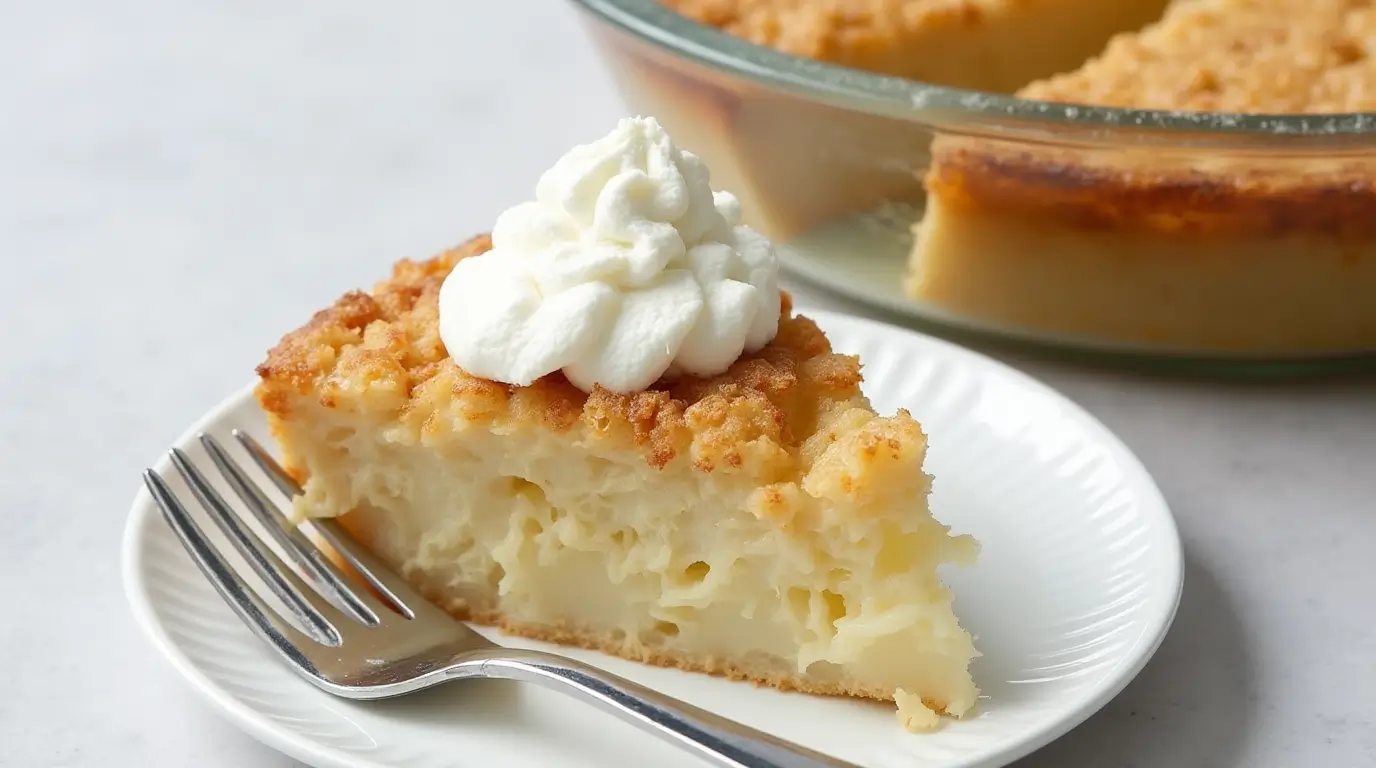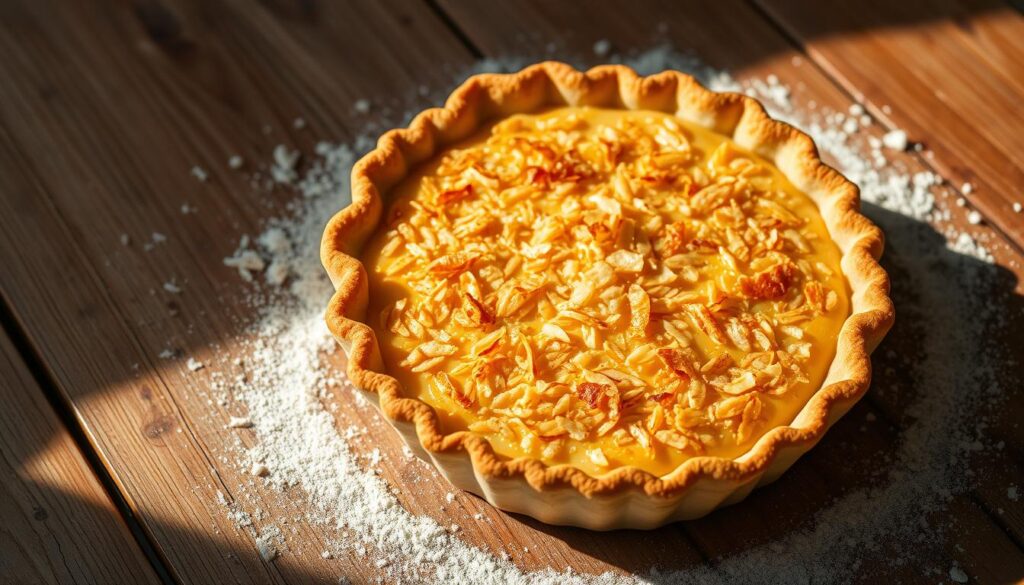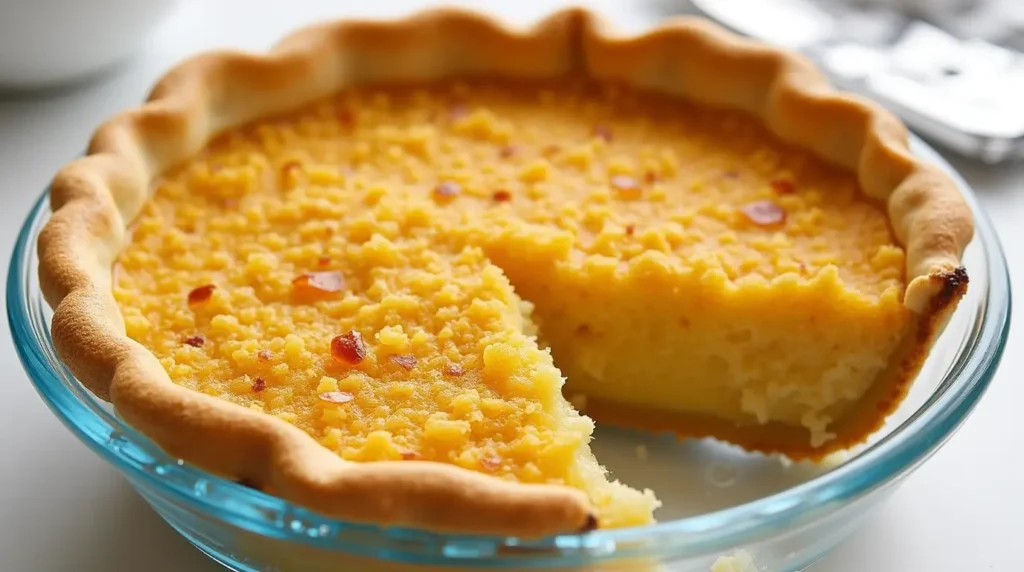The Best Coconut Pie Recipe You’ll Ever Make

Imagine being on a tropical island, surrounded by the sweet scent of coconut and the warmth of the sun. A delicious coconut pie can take you there, even if you’re far away.
Making a homemade coconut pie is easy. You just need a few ingredients and some basic kitchen tools. This way, you can make a dessert that will wow your family and friends.
The coconut adds a tropical twist to the traditional pie. It’s a mix of familiar and exotic flavors. This makes it great for any event.
Table of Contents
The Magic of Coconut Pie
Coconut pie is a simple yet elegant dessert that adds a touch of the exotic to American cuisine. You might have tasted it at a family gathering or a holiday dinner. But have you ever wondered what makes it so special?
What Makes Coconut Pie Special
The coconut cream pie is a beloved dessert for many. Its appeal comes from a flaky crust, a rich coconut filling, and a toasted meringue topping. The tropical flavor of coconut gives it a unique twist, making it a standout at any gathering.
Brief History of Coconut Pie in American Cuisine
The history of coconut pie in American cuisine is tied to the availability of coconuts. As global trade made coconuts more accessible, classic coconut pie became a staple in many American households. It’s especially enjoyed during holidays and special occasions.
The evolution of traditional coconut pie recipes over time has made it versatile. It continues to be enjoyed today.
Essential Ingredients for the Perfect Coconut Pie
To make a perfect coconut pie, you’ll need to gather a selection of key ingredients. The quality and combination of these ingredients will determine the flavor and texture of your homemade coconut cream pie.
Crust Ingredients
The crust is a fundamental component of your coconut pie. You have options when it comes to making the crust.
Flour, Butter, and Other Basics
For a traditional crust, you’ll need flour, cold butter, and ice water. The butter should be of high quality to ensure a flaky texture. Some recipes may also call for a pinch of salt to enhance the flavor.
Graham Cracker Crust Alternative
If you prefer a simpler crust or want a different texture, consider a graham cracker crust. This involves mixing crushed graham crackers with melted butter and sometimes sugar, then pressing the mixture into a pie dish.
Filling Ingredients
The filling is where the coconut flavor shines. You’ll need several key ingredients to create a rich and creamy filling.
Coconut Products: Milk, Cream, and Flakes
Coconut milk and coconut cream are essential for the filling’s creaminess. Shredded coconut or coconut flakes add texture and intensify the coconut flavor.
Sweeteners and Thickeners
Sugar or other sweeteners are necessary to balance the flavor. You’ll also need thickeners like cornstarch or eggs to achieve the right consistency for your cream pie recipe.
Topping Ingredients
The topping can add an extra layer of flavor and texture. Whipped cream or a meringue topping are popular choices for finishing your easy coconut pie.
Ingredient Substitutions for Dietary Restrictions
For those with dietary restrictions, there are alternatives. You can substitute gluten-free flour for a traditional crust or use dairy-free milk and cream alternatives in the filling. This way, everyone can enjoy a slice of your homemade coconut cream pie.
Kitchen Tools and Equipment You’ll Need
To make a tasty coconut cream pie, you need more than just ingredients. You also need the right kitchen tools. The right tools make the process easier and help your pie turn out great.
Essential Baking Tools
You’ll need some basic baking tools that you might already have. These include:
- A mixing bowl for combining ingredients
- A measuring cup and spoons for accurate measurements
- An electric mixer for beating eggs and cream
- A whisk for mixing the filling
- A pie dish (9-inch) for baking the pie
These tools are key for making a simple coconut pie. Having them will make the process much easier.
Optional but Helpful Equipment
While not necessary, some extra equipment can make things simpler. These include:
- A food processor for making a homemade crust
- A kitchen scale for precise ingredient measurement
- A pastry brush for egg wash or melted butter on the crust
| Equipment | Purpose |
|---|---|
| Mixing Bowl | Combining ingredients |
| Measuring Cups/Spoons | Accurate measurements |
| Electric Mixer | Beating eggs and cream |
| 9-inch Pie Dish | Baking the pie |
| Food Processor | Making homemade crust |
With these tools and equipment, you’ll be ready to make the best coconut pie. Whether you’re experienced or new to baking, the right tools are crucial for a delicious homemade coconut pie.
Preparing the Perfect Pie Crust
The foundation of a great coconut pie is its crust. It’s a key element that needs careful preparation. Whether you’re making a homemade coconut pie or a best coconut cream pie, the crust is essential.
Homemade vs. Store-Bought Crust Options
You can choose between homemade or store-bought crusts. Store-bought crusts are convenient, but homemade can make your traditional coconut pie stand out. Making your crust from scratch lets you control the ingredients and texture. This ensures it perfectly complements the coconut filling.
Step-by-Step Crust Preparation
Preparing the crust involves several key steps.
Mixing the Dough

Begin by mixing your dry ingredients. Then, add cold butter gradually until the dough forms.
Rolling and Shaping Techniques
Roll out the dough to about 1/8 inch thickness. Carefully place it in your pie dish, trimming the edges to fit.
Pre-Baking Your Crust: When and How
Pre-baking, or blind baking, is key to avoid a soggy crust. Line your crust with parchment paper, add pie weights, and bake at 375°F (190°C) for 15 minutes. This step makes your crust crisp and flaky, ready for your coconut filling.
By following these steps, you’ll create a homemade coconut pie with a delicious and appealing crust.
Creating the Coconut Filling
The heart of a delicious coconut pie is its creamy filling. To make this, you need to mix several important ingredients in a certain way.
To make the filling, cook sugar, cornstarch, and milk together. Then, mix it with egg yolks and coconut. This method makes the filling rich and creamy.
Traditional Coconut Cream Filling Method
The traditional way to make coconut cream filling involves a few steps:
- Cook sugar, cornstarch, and milk until it thickens.
- Temper egg yolks with the warm mixture to avoid scrambling.
- Add shredded coconut for more flavor and texture.
Balancing Sweetness and Coconut Flavor
Getting the sweetness and coconut flavor right is key. You can adjust sugar and coconut to your liking.
Achieving the Perfect Consistency
The filling’s consistency is vital for a great coconut pie recipe. It should be creamy but not too thin.
Troubleshooting Lumps and Texture Issues
If you run into lumps or texture problems, here’s what to do:
- Make sure cornstarch is fully dissolved before cooking.
- Stir the mix constantly while cooking to avoid lumps.
- If lumps appear, strain the mix through a fine-mesh sieve.
By following these steps and tips, you can make a delicious coconut pie with a smooth filling.
Complete Coconut Pie Recipe Step-by-Step
Making a tasty homemade coconut cream pie takes a few important steps. First, you need to prepare the crust. Then, bake the pie until it’s just right. Paying close attention to each step is key to success.
Preparing and Measuring All Ingredients
Start by measuring all your ingredients accurately. This includes the crust, filling, and any toppings. Getting the measurements right helps you get the perfect taste and texture in your coconut cream pie.
Mixing the Filling Components
The filling is crucial for your coconut cream pie. Mix cream, sugar, eggs, and shredded coconut in a certain order. This ensures the right consistency and flavor.
Stovetop Cooking Method
Cooking the filling on the stovetop is traditional. It lets you control the temperature. This is important to cook the eggs right without scrambling them. It makes the filling smooth and creamy.
Incorporating Coconut Properly
When adding shredded coconut, fold it gently. This avoids air pockets. It makes sure the coconut is spread evenly, giving your pie a consistent taste and texture.
| Ingredient | Quantity | Purpose |
|---|---|---|
| Shredded Coconut | 1 cup | Adds coconut flavor and texture |
| Heavy Cream | 1 cup | Provides richness and creaminess |
| Sugar | 1/2 cup | Sweetens the filling |
Assembling the Pie
Once your crust is ready and your filling is made, it’s time to put the pie together. Pour the filling into the crust and smooth the top.
Baking Instructions and Times
Bake the pie at 350°F (175°C) for 40-45 minutes. It’s done when the filling is set and the crust is golden.
Visual Cues for Doneness
The pie is ready when the edges are set and the center jiggles a bit. Don’t overbake, as it can make the filling too firm and the crust too dark.
By following these steps, you’ll make a delicious homemade coconut cream pie that will wow everyone. Remember, the secret to success is in the details. From measuring ingredients right to baking the pie perfectly.
Topping Your Coconut Pie
The final touch for your homemade coconut pie is the topping. It can make the flavor and look better. You can pick from several options, each adding a special twist to your best coconut pie recipe.
Classic Whipped Cream Topping
Whipped cream is a timeless choice for topping your coconut pie. It’s easy yet fancy. You’ll need heavy cream, sugar, and a bit of vanilla extract. Just whip these until they’re stiff.
Making Stabilized Whipped Cream
For whipped cream that lasts longer, add gelatin or cornstarch. This is good for outdoor or warm events.
- Chill your bowl and beaters before whipping.
- Add a teaspoon of gelatin (softened in a tablespoon of cold water) to the cream before whipping.
- Whip until stiff peaks form, being careful not to over-whip.
Meringue Topping Alternative
For a different topping, try meringue. It adds a nice texture to your simple coconut pie. It’s also a good use for leftover egg whites from the filling.
To make meringue, beat egg whites until frothy. Then add sugar slowly and keep beating until stiff. Spread or pipe it on the pie and bake until it’s golden.
Toasted Coconut Garnish
Adding toasted coconut flakes on top is a great idea. It boosts the coconut flavor and adds texture. It’s a simple yet effective way to improve your coconut pie.
Methods for Perfectly Toasting Coconut
To toast coconut flakes, spread them on a baking sheet. Bake in a 350°F oven, stirring often, until golden. Be careful not to burn it.
You can also toast coconut in a skillet over medium heat. Stir constantly until it’s toasted to your liking.
Delicious Coconut Pie Variations to Try
Coconut pie is a versatile dessert that can be modified in countless ways to suit your taste. Whether you’re looking to stick to traditional flavors or experiment with something entirely new, there are numerous variations to try.
Chocolate Coconut Pie
For chocolate lovers, adding cocoa powder or melted chocolate to the coconut filling can create a decadent twist on the classic coconut cream pie recipe. You can also sprinkle chocolate shavings on top for extra flavor.
Pineapple Coconut Pie
Incorporating pineapple into your coconut pie can add a tropical flavor. You can mix pineapple chunks into the filling or use pineapple juice instead of some of the cream for added moisture.

Coconut Custard Pie
A coconut custard pie is a creamy and rich dessert. To make it, you’ll need to adjust the filling by adding more eggs and baking it until the custard is set.
No-Bake Coconut Pie Options
If you prefer not to bake your pie, you can make a no-bake version using a graham cracker crust and a filling made with cream cheese, coconut cream, and sweetened condensed milk. Chill until set, and you’ll have an easy coconut pie that’s perfect for warm weather.
These variations show that homemade coconut pie can be adapted to suit any taste or dietary preference. Feel free to experiment with different combinations to find your new favorite dessert.
Troubleshooting Common Coconut Pie Problems
Coconut pie lovers sometimes face a few common issues. But, these problems can be solved with the right methods. Whether you’re making a classic coconut pie or trying a new recipe, these tips will help you make a tasty dessert.
Fixing a Soggy Crust
A soggy crust can be a letdown. To prevent this, make sure your crust is well-prebaked. You can also use pie weights or bake in a hot oven to crisp it up.
Dealing with Runny Filling
If your coconut cream filling is too runny, it might be because it’s not cooked enough or has the wrong mix of ingredients. Try cooking it a bit longer or adding more cornstarch to thicken it.
Preventing Burnt Toppings
To stop your meringue topping from burning, watch it closely while it’s baking. You can also cover the edges with foil to stop them from getting too brown.
Rescuing Overcooked or Undercooked Pies
If your pie is overcooked, you can hide the dryness with whipped cream or a glaze. For pies that are undercooked, just bake them a bit longer.
| Issue | Solution |
|---|---|
| Soggy Crust | Pre-bake crust, use pie weights |
| Runny Filling | Cook longer, add more cornstarch |
| Burnt Toppings | Monitor baking, cover edges with foil |
By using these troubleshooting tips, you’ll be on your way to making the best coconut cream pie. Enjoy baking!
Serving and Storage Tips
When you serve your coconut cream pie, make sure it’s as good as it tastes. Serving your homemade coconut pie at the right temperature is key. Also, storing it properly helps keep its quality and flavor.
Best Temperature for Serving
Serve your delicious coconut pie chilled for the best taste. Take it out of the fridge 10-15 minutes before serving. This lets it soften a bit, making the flavors and texture better.
Proper Storage Methods
Keep your coconut pie in the fridge, covered with plastic wrap or foil. This stops it from drying out. It stays fresh for 3-4 days.
Freezing and Thawing Your Coconut Pie
Freezing is okay for a simple coconut cream pie, unlike meringue pies. Wrap it well and freeze for up to 2 months. Thaw it in the fridge overnight before you serve it.
Making Coconut Pie Ahead of Time
You can make your coconut cream pie ahead of time. Make it up to a day before, but add toppings like whipped cream or toasted coconut just before serving. This keeps them fresh and looking good.
Conclusion: Enjoying Your Homemade Coconut Pie
Now that you’ve baked a delicious homemade coconut pie, it’s time to enjoy it. This classic recipe will become a favorite in your home. It’s a treat that’s perfect for sharing with loved ones.
Making a coconut pie from scratch is a journey. It starts with the pie crust and ends with the coconut filling and topping. The effort is worth it for the amazing taste and the joy it brings to others.
Don’t be afraid to try new things with your coconut pie. Add chocolate or pineapple for a unique twist. No matter what, your coconut pie will be a hit. So, grab a slice and savor the taste of your homemade masterpiece.
FAQ
What is the best type of coconut to use for coconut cream pie?
For the best taste, use full-fat coconut milk or cream. You can also use shredded coconut, sweetened or unsweetened, based on your preference.
Can I make a coconut pie without baking it?
Yes, you can make a no-bake coconut pie. It has a graham cracker crust and a filling of cream cheese, whipped cream, and shredded coconut.
How do I prevent my coconut pie crust from becoming soggy?
To avoid a soggy crust, pre-bake it before adding the filling. You can also use toasted coconut or a thin layer of chocolate to protect it.
What’s the best way to toast coconut for garnishing my pie?
Spread shredded coconut on a baking sheet and bake at 325°F, stirring often, until lightly golden. Watch it closely to prevent burning.
Can I substitute coconut cream with something else in a coconut cream pie recipe?
While you can try alternatives, coconut cream is key for the real flavor and texture. You can mix it with heavy cream or Greek yogurt for a lighter version.
How do I achieve a smooth coconut filling without lumps?
To avoid lumps, mix your filling ingredients well, especially with thickeners like cornstarch or flour. Cooking it over medium heat, stirring constantly, until it thickens, also helps.
How long does homemade coconut pie last?
Homemade coconut pie lasts 3 to 4 days in the fridge. It’s best eaten fresh for the best taste and texture.
Can I freeze coconut pie?
Yes, you can freeze coconut pie. Freeze it before adding whipped cream toppings. Wrap it tightly and store in the freezer for up to 2 months. Thaw in the fridge before serving.
How do I make a stabilized whipped cream topping for my coconut pie?
To stabilize whipped cream, add a tablespoon of cornstarch or gelatin to the cream before whipping. This keeps it firm longer.
What are some variations I can try with my coconut pie recipe?
Try different flavors by adding chocolate chips, nuts, or fruit. You can also experiment with different milks or creams for a unique taste.
How did you like the recipe?
There are no reviews yet. Be the first one to write one.
